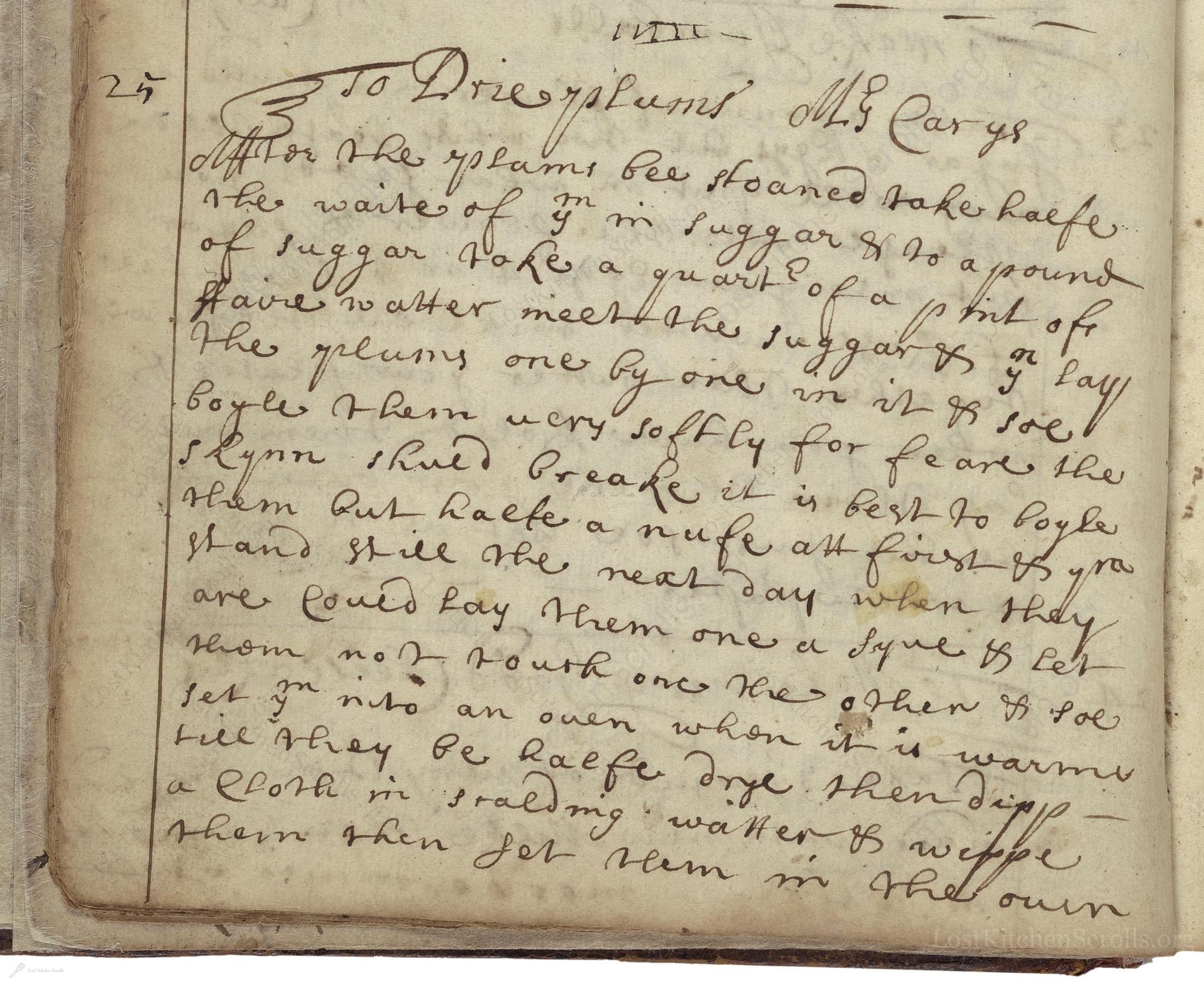To Drie Plums Mrs Carys
From the treasured pages of Receipt book of Penelope Jephson
Written by Penelope Patrick

To Drie Plums Mrs Carys
"After the plums bee stoaned take halfe the waite of ym in suggar & to a pound of suggar take a quart & a pint of have watter meete the suggar & yr lay the plums one by one in it & soe boyle them very softly for feare the skyn shud breake it is best to boyle them but halfe a nufe att first & ym stand still the next day when they are couled lay them one a syve & lett them not touch one the other & soe set ym into an oven when it is warme till they be halfe drye then dipp a cloth in scalding watter & weype them then set them in the oven againe & drie them upps"
Note on the Original Text
Recipes from this period were written in a conversational and instructive style, meant to guide rather than measure. Spelling was fluid ('stoaned' for 'stoned', 'boyle' for 'boil', 'att' for 'at'), reflecting the lack of standardization in English orthography. Directions focus on sensory cues ('boyle them very softly', 'set into the oven when it is warme'), trusting the cook's experience and judgement.

Title
Receipt book of Penelope Jephson (1673)
You can also click the book image above to peruse the original tome
Writer
Penelope Patrick
Era
1673
Publisher
Unknown
Background
Step back into the sumptuous kitchens of the late 17th century with Penelope Patrick’s culinary collection—a feast of historic recipes, secret tips, and the irresistible flavors of Restoration England all bound together in a handwritten treasure.
Kindly made available by
Folger Shakespeare Library
This recipe for dried plums hails from the late 17th century, recorded by Penelope Patrick around 1671–1675. At the time, preserving fruit was essential for making use of seasonal abundance before the advent of refrigeration. Such sugar-based preserves were the domain of well-to-do households, reflecting both status and culinary sophistication. The recipe writer, 'Mrs Carys', likely refers to a family or household cook skilled in such arts, working within the domestic sphere of Restoration England.

Back in the day, the cook would have used a large cauldron or copper preserving pan over an open hearth to simmer the plums in syrup. Plums would be lifted out with wooden spoons or slotted ladles. To dry them, sieves or woven racks would be employed, set near the gentle residual heat of an oven—often the brick bread oven after baking, as it cooled. Muslin or linen cloths would serve to wipe excess syrup from the plums.
Prep Time
30 mins
Cook Time
2 hrs
Servings
10
We've done our best to adapt this historical recipe for modern kitchens, but some details may still need refinement. We warmly welcome feedback from fellow cooks and culinary historians — your insights support the entire community!
Ingredients
- 2.2 lbs plums, fresh (or substitute other stone fruits such as apricots if plums unavailable)
- 1.1 lbs granulated sugar
- 7 1/4 cups water
Instructions
- To recreate Mrs.
- Cary's dried plums today, begin by pitting your plums.
- Weigh them, and measure out half their weight in granulated sugar.
- For every 1 pound of sugar, mix 7 1/4 cups of water (about 3 quarts), bringing it to the boil until the sugar dissolves.
- Gently add the plums one by one into the simmering syrup, taking care not to break their skins.
- Simmer softly for a short time—no more than half the usual time plums take to soften, to avoid overcooking.
- Remove from heat and leave the plums to cool and rest overnight in their syrup.
- The next day, carefully lift the plums out and set them on a wire rack lined with a sieve or baking rack, making sure none touch.
- Place in a warm oven (about 195°F, no hotter) for an hour or two to half-dry.
- Briefly dab each plum with a clean cloth dipped in hot water to remove excess syrup, then return to the oven to finish drying until they reach your desired consistency.
Estimated Calories
170 per serving
Cooking Estimates
It will take about 30 minutes to prepare the plums and syrup, plus 10 to 15 minutes for simmering. The rest of the time is spent soaking overnight and drying them in the oven. Each serving is about 100 grams of finished dried plums and has roughly 170 calories.
As noted above, we have made our best effort to translate and adapt this historical recipe for modern kitchens, taking into account ingredients nowadays, cooking techniques, measurements, and so on. However, historical recipes often contain assumptions that require interpretation.
We'd love for anyone to help improve these adaptations. Community contributions are highly welcome. If you have suggestions, corrections, or cooking tips based on your experience with this recipe, please share them below.
Join the Discussion
Rate This Recipe
Dietary Preference
Main Ingredients

Den Bockfisch In Einer Fleisch Suppen Zu Kochen
This recipe hails from a German manuscript cookbook compiled in 1696, a time whe...

Die Grieß Nudlen Zumachen
This recipe comes from a rather mysterious manuscript cookbook, penned anonymous...

Ein Boudain
This recipe comes from an anonymous German-language manuscript cookbook from 169...

Ein Gesaltzen Citroni
This recipe, dating from 1696, comes from an extensive anonymous German cookbook...
Browse our complete collection of time-honored recipes



